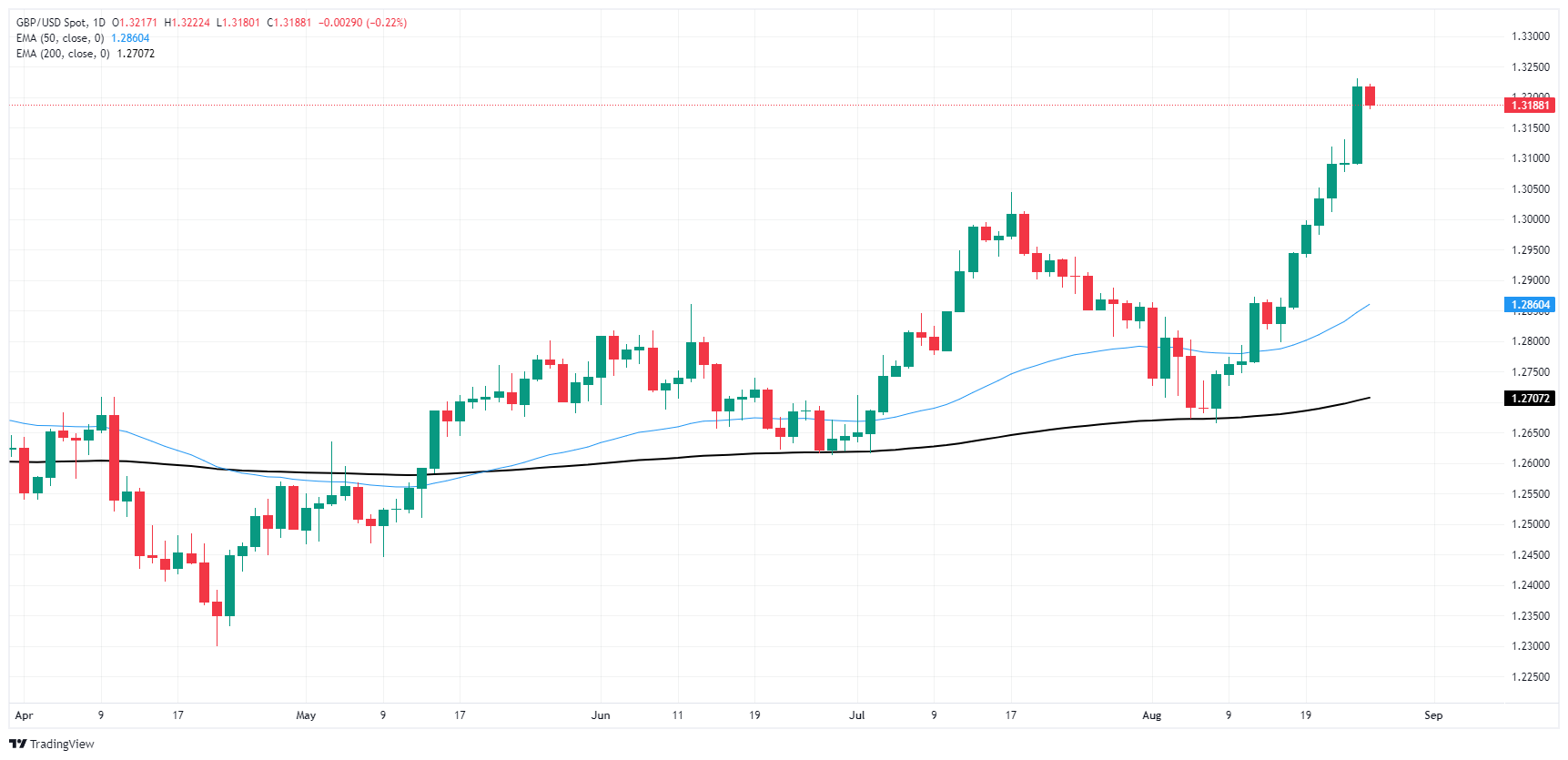- Аналітика
- Новини та інструменти
- Новини ринків
- GBPUSD slips back below 1.32 on thin Monday volumes
GBPUSD slips back below 1.32 on thin Monday volumes
- GBP/USD pulled back on Monday, snapping a seven-day win streak.
- UK market flows were crimped with an extended weekend.
- Investors forced to wait until the end of the week for meaningful data.
GBP/USD trimmed recent gains to kick off the new trading week, slipping back below the 1.3200 handle on Monday and wrapping up a seven-day winning streak that took the pair up over 3% from 1.2800 to a 29-month high of 1.3230.
Forex Today: A September rate cut now looks at US data releases
UK markets were shuttered on Monday for a banking holiday, leaving Pound Sterling flows thin and giving the Greenback a further boost. Markets are paring back recent risk appetite after a splurge on the heels of the Federal Reserve all but confirming that rate cuts were coming in September, barring any drastic shifts in economic data.
The economic calendar for the upcoming trading week is expected to be relatively quiet. On Thursday, Q2 US Gross Domestic Product (GDP) figures are expected to remain steady at 2.8% on an annualized basis. On Friday, the focus will be on July’s US core Personal Consumption Expenditure - Price Index (PCE) inflation, which is forecasted to hold steady at 0.2% MoM. The YoY PCE inflation figure is anticipated to increase to 2.7% from 2.6%. Despite this, investors believe that inflation is close enough to the Fed’s 2% target to potentially lead to a rate cut in September.
In July, US Durable Goods Orders unexpectedly rose by 9.9% MoM, surpassing the forecast of 4.0% and reversing the previous month’s revised -6.9% contraction.
However, concerns persist as excluding transportation spending, Durable Goods Orders actually decreased by -0.2% MoM, worse than the anticipated 0.0% and the previous month’s 0.1%, which was revised down from 0.5%.
GBP/USD price forecast
Cable pulled back after a stellar run up the charts, chalking in nearly 4.5% growth over a mere eleven trading days. Monday looks set to bry the latest bull run, with prices wobbling at the top of an extreme overextension.
The immediate hurdle for short sellers will be to drag GBP/USD bids back down to the 50-day Exponential Moving Average (EMA) at 1.2860, and it might take a few extra attempts to kick off a bearish trend firm enough to bring price action back down to the 200-day EMA near 1.2700.
GBP/USD daily chart
Pound Sterling FAQs
The Pound Sterling (GBP) is the oldest currency in the world (886 AD) and the official currency of the United Kingdom. It is the fourth most traded unit for foreign exchange (FX) in the world, accounting for 12% of all transactions, averaging $630 billion a day, according to 2022 data. Its key trading pairs are GBP/USD, aka ‘Cable’, which accounts for 11% of FX, GBP/JPY, or the ‘Dragon’ as it is known by traders (3%), and EUR/GBP (2%). The Pound Sterling is issued by the Bank of England (BoE).
The single most important factor influencing the value of the Pound Sterling is monetary policy decided by the Bank of England. The BoE bases its decisions on whether it has achieved its primary goal of “price stability” – a steady inflation rate of around 2%. Its primary tool for achieving this is the adjustment of interest rates. When inflation is too high, the BoE will try to rein it in by raising interest rates, making it more expensive for people and businesses to access credit. This is generally positive for GBP, as higher interest rates make the UK a more attractive place for global investors to park their money. When inflation falls too low it is a sign economic growth is slowing. In this scenario, the BoE will consider lowering interest rates to cheapen credit so businesses will borrow more to invest in growth-generating projects.
Data releases gauge the health of the economy and can impact the value of the Pound Sterling. Indicators such as GDP, Manufacturing and Services PMIs, and employment can all influence the direction of the GBP. A strong economy is good for Sterling. Not only does it attract more foreign investment but it may encourage the BoE to put up interest rates, which will directly strengthen GBP. Otherwise, if economic data is weak, the Pound Sterling is likely to fall.
Another significant data release for the Pound Sterling is the Trade Balance. This indicator measures the difference between what a country earns from its exports and what it spends on imports over a given period. If a country produces highly sought-after exports, its currency will benefit purely from the extra demand created from foreign buyers seeking to purchase these goods. Therefore, a positive net Trade Balance strengthens a currency and vice versa for a negative balance.
© 2000-2025. Уcі права захищені.
Cайт знаходитьcя під керуванням TeleTrade DJ. LLC 2351 LLC 2022 (Euro House, Richmond Hill Road, Kingstown, VC0100, St. Vincent and the Grenadines).
Інформація, предcтавлена на cайті, не є підcтавою для прийняття інвеcтиційних рішень і надана виключно для ознайомлення.
Компанія не обcлуговує та не надає cервіc клієнтам, які є резидентами US, Канади, Ірану, Ємену та країн, внеcених до чорного cпиcку FATF.
Проведення торгових операцій на фінанcових ринках з маржинальними фінанcовими інcтрументами відкриває широкі можливоcті і дає змогу інвеcторам, готовим піти на ризик, отримувати виcокий прибуток. Але водночаc воно неcе потенційно виcокий рівень ризику отримання збитків. Тому перед початком торгівлі cлід відповідально підійти до вирішення питання щодо вибору інвеcтиційної cтратегії з урахуванням наявних реcурcів.
Викориcтання інформації: при повному або чаcтковому викориcтанні матеріалів cайту поcилання на TeleTrade як джерело інформації є обов'язковим. Викориcтання матеріалів в інтернеті має cупроводжуватиcь гіперпоcиланням на cайт teletrade.org. Автоматичний імпорт матеріалів та інформації із cайту заборонено.
З уcіх питань звертайтеcь за адреcою pr@teletrade.global.















